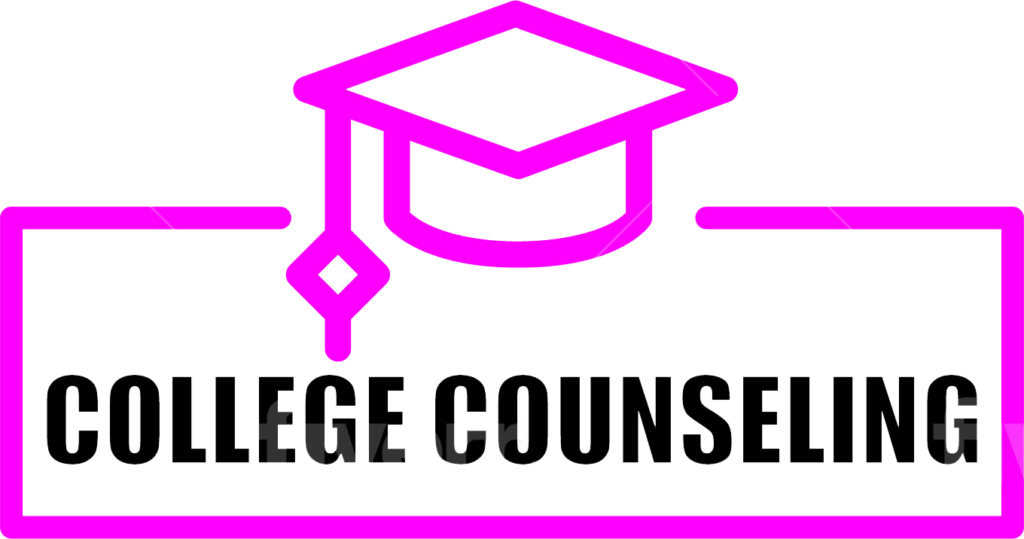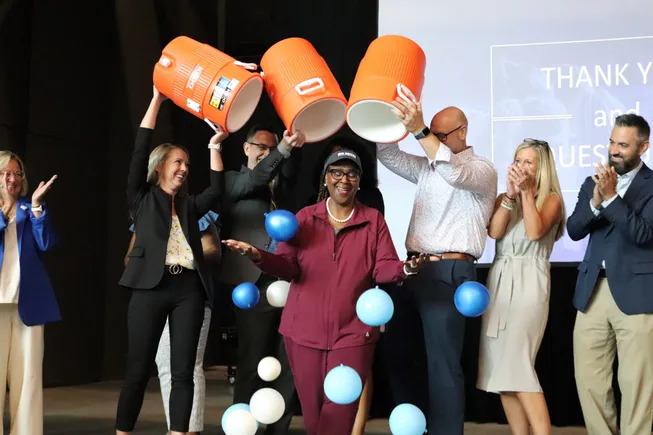NEW ORLEANS — Between 2020 and 2024, student attendance in Missouri’s Springfield Public Schools dipped from 94.73% to 90.63%.
Like many other school districts nationwide, Springfield’s attendance rates took a hit from the COVID-19 pandemic.
Data from the American Institutes for Research shows fall 2020 attendance rates nationwide for elementary school at 92%, middle school at 90%, and high school at 89% — down from pre-pandemic averages of 95% for elementary and 92% for middle and high school.
And because of the global health crisis, the state kept Springfield at its 2019-20 attendance numbers for funding purposes, Superintendent Grenita Lathan told attendees in March at the annual conference of AASA, The School Superintendents Association, in New Orleans.
But with the state’s hold harmless order on attendance about to sunset, Lathan said, officials in the 24,500-student district knew that they needed to boost attendance during the 2023-24 school year. So they set a goal: By the end of that school year, they would raise attendance to 92%.
“When it comes to school attendance, 90% is not an A.”
Springfield Public Schools’ messaging on attendance
Announcing that charge during her annual state of the schools address in August 2023, Lathan said chamber of commerce members and the community at large needed to understand the impact that a 2 percentage-point attendance increase would have.
“That would bring in anywhere from $3 [million] to $4 million in funding that would help us with different programs,” Lathan said.
Lathan and other district officials laid out a districtwide strategic plan that included a communication timeline, monthly updates to 300 local business leaders, and a promise that Lathan would let herself be publicly doused in Powerade if the district reached its goal. Here are the keys to how officials rallied the community to work toward the attendance goal.
Keep it simple and be bold
“It was important that we had buy-in from everyone in the district so that the messaging would resonate with everyone in the community,” said Stephen Hall, the district’s chief communications officer.
To that end, the district prioritized making its messaging simple, direct and bold in presentation. This was reflected not only in the attendance campaign’s slogan — “Attend today, succeed forever” — but also in messaging on social media and on signage around the city.
In their car pickup lines, each of Springfield Public Schools’ 50 elementary, middle and high school buildings displayed five 18-inch by 24-inch yard signs heralding the directive “Attend daily. On time. All day.”
Additionally, the district used digital billboards at three major intersections to get its message out. For only $500, Hall said, the district was able to get more than 250,000 ad placements on the billboards over 20 days.
The attendance initiative became an easy, noncontroversial message for media and business partners to get behind. District leaders asked businesses to be creative in incorporating the campaign into their own messaging and also to sponsor PSAs on local TV stations.
Furthermore, the district sent monthly news releases to local media showing the district’s progress. One local reporter even made it his mission to try to calculate the progress on his own, because he wanted to beat the competition on getting the story out once the district hit its goal, Hall said.
On social media, the district boldly declared, “When it comes to school attendance, 90% is not an A.” The school system supplemented these posts with graphics that simplified attendance data. Visuals, for instance, demonstrated how much of an impact each successive absence could have on a student’s performance, as defined using their GPA: Where a student with four absences might average a 3.63 GPA, a student with 35 absences might have a 2.29.
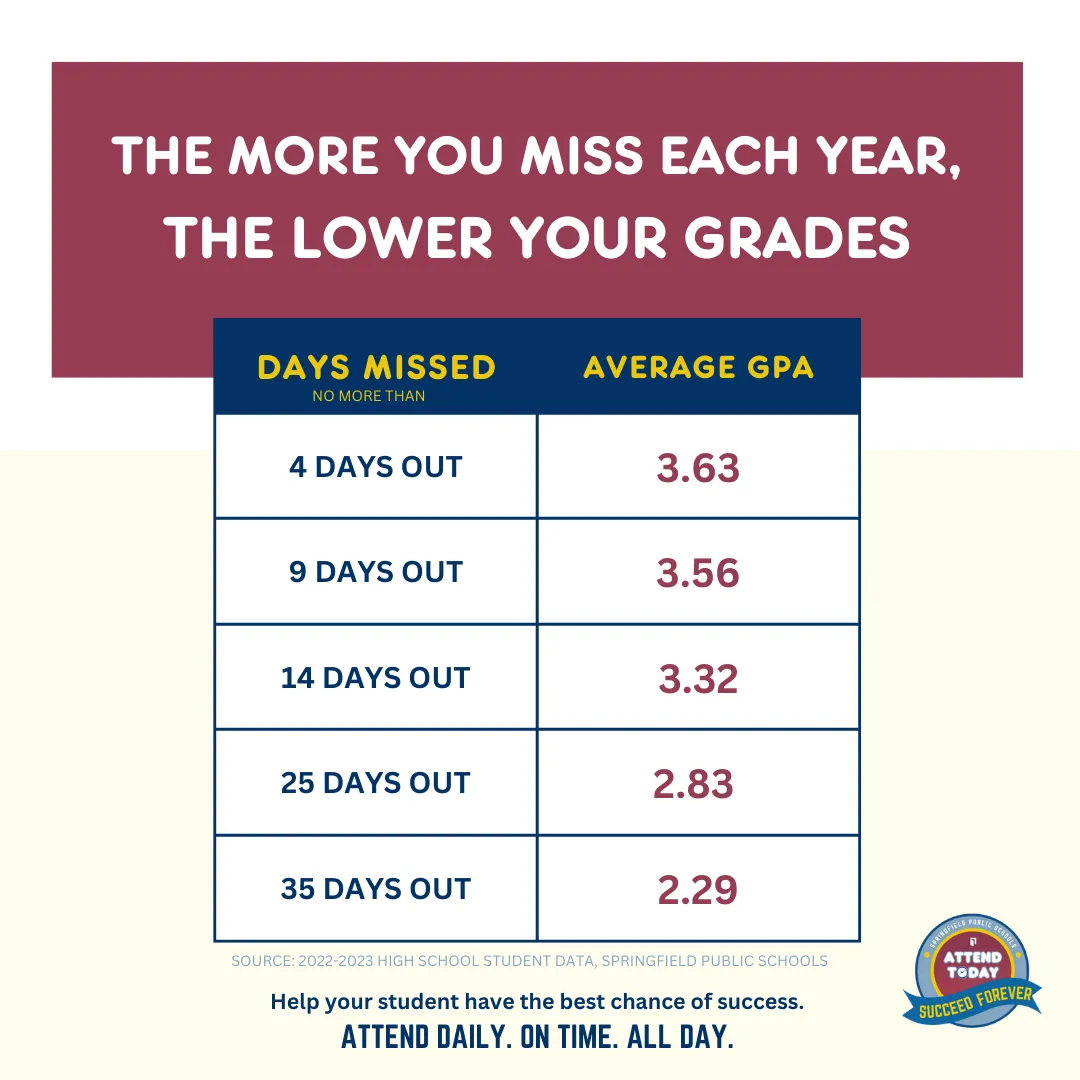
A social media graphic from Springfield Public Schools shows how prolonged absences correlate to potential impacts on student GPAs.
Permission granted by Springfield Public Schools
Don’t sweat the pushback
Shifting a community’s mindset isn’t without its hiccups, however. If your messaging is working, you should expect to receive pushback, the Springfield officials told AASA conference attendees.
“Because it was consistent, because it was bold, and because we were holding people accountable, we heard quite a bit of feedback,” Hall said.
One negative Facebook comment shared with attendees, for instance, read in part: “The SPS attendance obsession is why everyone in our house has been sick the last month. Our kids report they have been surrounded by sick kids at school who have been bullied by administrators into thinking they cannot miss any school. The result? Our kids are getting sick because sick kids are at school.”
When concerns like this arose, Hall said the district made a point of reminding parents that it’s still important to keep their kids at home when they are ill, and that punishing sick children wasn’t the purpose of the attendance campaign.
The district used the pushback as an opportunity to have school attendance officers and liaisons talk with families to identify barriers to attendance and offer solutions and resources to help address the issue. These included six attendance advisors who provided supports for transportation and health needs, counseling referrals, home visits, phone calls and address checks.
But pushback didn’t just come from parents: Students also leveled criticism against the district using social media comment sections, the district website’s feedback platform, and even a cover story in Kickapoo High School’s quarterly KHQ Today Magazine. Among their complaints: participation in school activities like dances, art shows, and public-facing performances such as band or choir relied upon attendance staying above a certain level.
“The only way to move metrics by 2 percentage points is for people to understand that there’s accountability, that there is consistency. And so it does ruffle some feathers sometimes, because they’re hearing it from multiple levels of the organization,” Hall said.
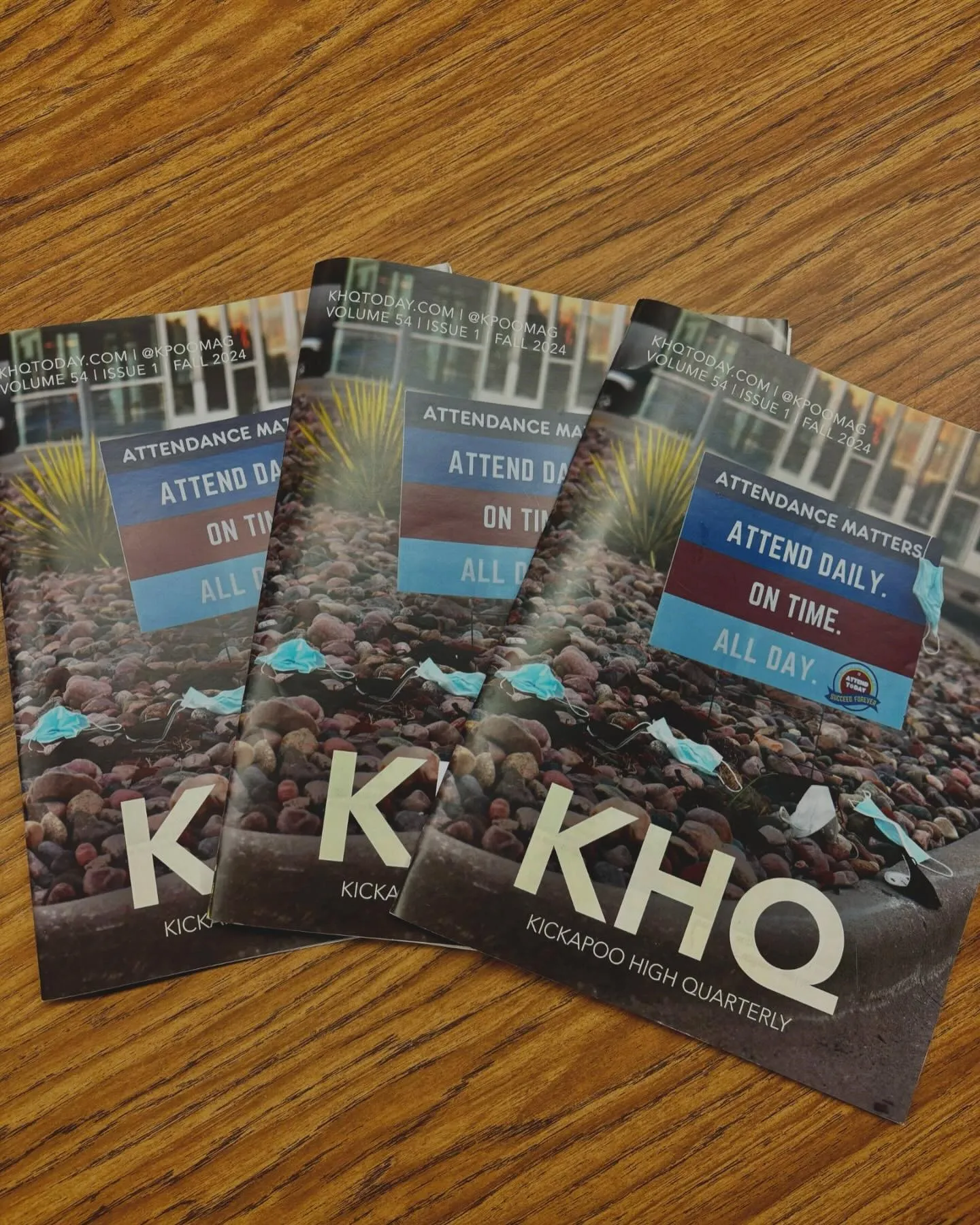
Yard signs promoting school attendance are pictured on the cover of the Fall 2024 issue of KHQ Today Magazine, a quarterly publication produced by students at Kickapoo High School in Springfield Public Schools in Missouri.
Permission granted by Springfield Public Schools
Leverage virtual learning
Not only is Springfield Public Schools the largest school system in Missouri, but it has the state’s largest virtual learning program, which serves around 400 school districts statewide.
“We have, in-house, a really robust virtual learning program,” said Ben Hackenwerth, the district’s chief strategy and innovation officer. “In Missouri, the way we’re funded, if a student is a virtual student, they automatically receive 100% attendance as long as they are participating.”
While there are specifics on how that participation has to be monitored and reported, Hackenwerth said, this situation provided an opportunity to meet with parents of students who were struggling in the regular school environment and offer them an option that might suit their child better.
The virtual learning program also gave Springfield a pathway to rethink suspensions.
For students on long-term suspensions, “we would give them the option of becoming a virtual student with the expectation that they could not be on campus,” Hackenwerth said. “So instead of taking that attendance hit, they could continue learning in a virtual setting, and it didn’t impact our attendance in a negative way.”
At the high school level, leveraging virtual learning options raised attendance by 1.5 percentage points.
It’s a small percentage of students in the grand scheme of things, “but it’s still good for kids,” Hackenwerth said.
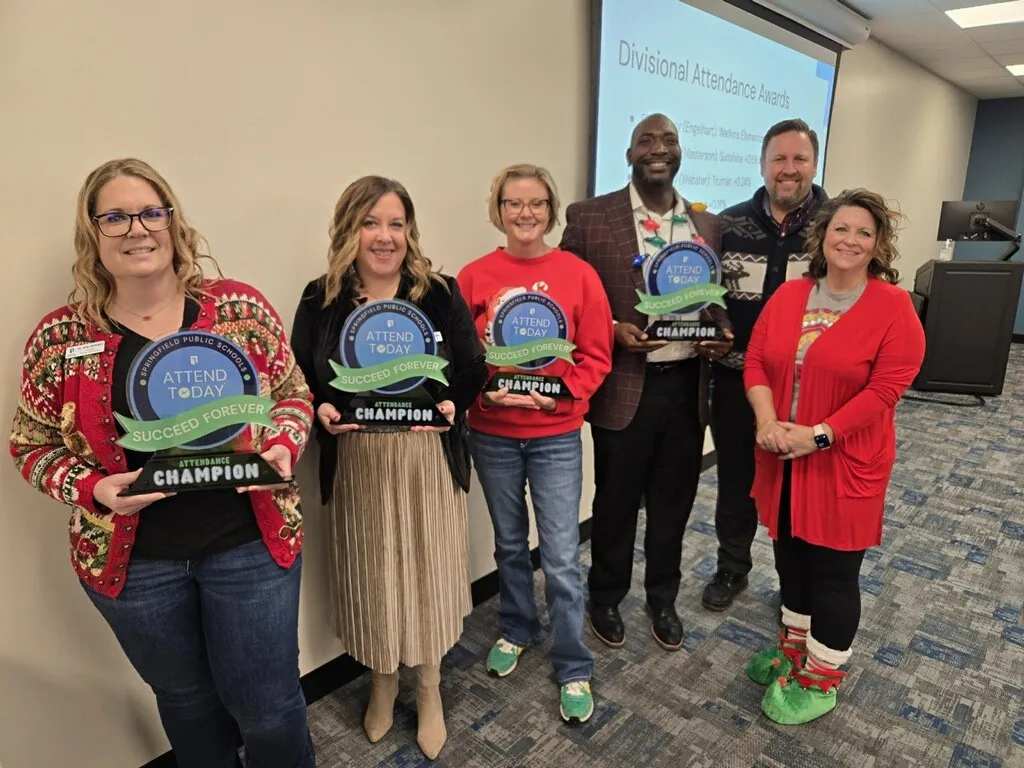
Springfield Public Schools principals pose with their attendance trophies. (L-R) Truman Elementary Principal Sara Shevchuk, Watkins Elementary Principal Joanna Brockwell, Sunshine Elementary Principal Tracy Daniels, Pershing K-8 Principal Tommy Wells, Middle School and K-8 Campuses Director Andre Illig, and Elementary Schools Director Mykie Nash.
Permission granted by Springfield Public Schools
Reward progress
Of course, recognition for successes achieved is crucial to keeping morale up during an effort like Springfield’s attendance campaign. So, the district each month awarded trophies to principals in categories such as largest attendance gain year over year, most improved over the past month, and 95% attendance or better.But what about Lathan’s Powerade promise? Did Springfield hit its goal?
The short answer is “yes.” At her 2024 State of the Schools address in August, Lathan announced the district’s attendance had reached 91.78%, which was rounded up to 92%.
Lathan noted that one school in particular stood out throughout the campaign: McGregor Elementary School. The 281-student, 90%-free-lunch campus led by Principal Rebekah Kirby — then a first-year principal — raised its attendance by 3.56 percentage points.
“Her children were outperforming our higher-performing campuses where attendance is not an issue,” Lathan said.
With that in mind, at Lathan’s August 2024 state of the schools address, Kirby, along with some of her building’s teachers and students, got to do the honors of dumping a bucket of Powerade over Lathan’s head.
“It truly was worth it to be able to hit that goal and for them to be able to celebrate,” Lathan said.
